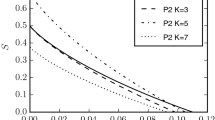Abstract
A simple proof of security of the BB84 protocol is presented in this paper. The proof is achieved in an information-theoretic way without referring to the formalism of quantum error-correction codes. Two examples are presented and discussed, showing that some previous results are special cases of the framework in this paper. It is suggested that the proof here sheds new light on security analysis of quantum key distribution, and that its technique may also improve the studies of other quantum information tasks.

Similar content being viewed by others
Explore related subjects
Discover the latest articles, news and stories from top researchers in related subjects.References
Nielsen, M.A., Chuang, I.L.: Quantum Computation and Quantum Information. Cambridge University Press, Cambridge (2000)
Diffie, W., Hellman, M.: New directions in cryptography. IEEE Trans. Inf. Theory 22, 644–654 (1976)
Merkle, R.: Secure communications over insecure channels. Commun. ACM 21, 294–299 (1978)
Rivest, R.L., Shamir, A., Adleman, L.M.: A method of obtaining digital signatures and public-key cryptosystems. Commun. ACM 21, 120–126 (1978)
Scarani, V., Bechmann-Pasquinucci, H., Cerf, N.J., Dušek, M., Lütkenhaus, N., Peev, M.: The security of practical quantum key distribution. Rev. Mod. Phys. 81, 1301 (2009)
Gisin, N., Ribordy, G., Tittel, W., Zbinden, H.: Quantum cryptography. Rev. Mod. Phys. 74, 145 (2002)
Vernam, G.S.: Cipher printing telegraph systems for secret wire and radio telegraphic communications. J. Am. Inst. Electr. Eng. 45, 109–115 (1926)
Bennett, C.H., Brassard, G.: Quantum cryptography: public key distribution and coin tossing. In: Proceedings IEEE International Conference on Computers, Systems and Signal Processing, Bangalore, India, 1984, pp. 175–179. IEEE, New York (1984)
Lo, H.-K., Curty, M., Qi, B.: Measurement-device-independent quantum key distribution. Phys. Rev. Lett. 108, 130503 (2012)
Yin, Z.-Q., Fung, C.-H.F., Ma, X., Zhang, C.-M., Li, H.-W., Chen, W., Wang, S., Guo, G.-C., Han, Z.-F.: Measurement-device-independent quantum key distribution with uncharacterized qubit sources. Phys. Rev. A 88, 062322 (2013)
Yin, Z.-Q., Fung, C.-H.F., Ma, X., Zhang, C.-M., Li, H.-W., Chen, W., Wang, S., Guo, G.-C., Han, Z.-F.: Mismatched-basis statistics enable quantum key distribution with uncharacterized qubit sources. Phys. Rev. A 90, 052319 (2014)
Bennett, C.H., Brassard, G., Mermin, N.D.: Quantum cryptography without Bell’s theorem. Phys. Rev. Lett. 68, 557 (1992)
Calderbank, A.R., Shor, P.W.: Good quantum error-correcting codes exist. Phys. Rev. A 54, 1098–1105 (1996)
Steane, A.M.: Multiple-particle interference and quantum error correction. Proc. R. Soc. Lond. A 452, 2551–2577 (1996)
Lo, H.-K., Chau, H.F.: Unconditional security of quantum key distribution over arbitrarily long distances. Science 283, 2050–2056 (1999)
Shor, P.W., Preskill, J.: Simple proof of security of the BB84 quantum key distribution protocol. Phys. Rev. Lett. 85, 441 (2000)
Bennett, C.H., DiVincenzo, D.P., Smolin, J.A., Wootters, W.K.: Mixed-state entanglement and quantum error correction. Phys. Rev. A 54, 3824–3851 (1996)
Yuen, H.P.: Security of quantum key distribution. IEEE Access 4, 724–749 (2016)
Mayers, D.: Unconditional security in quantum cryptography. J. ACM 48, 351–406 (2001)
Biham, E., Boyer, M., Boykin, P.O., Mor, T., Roychowdhury, V.: A proof of the security of quantum key distribution (extended abstract). In: Proceedings of the Thirty-Second Annual ACM Symposium on Theory of Computing, pp. 715–724. ACM Press, New York (2000)
Bruß, D.: Optimal eavesdropping in quantum cryptography with six states. Phys. Rev. Lett. 81, 3018 (1998)
Bechmann-Pasquinucci, H., Gisin, N.: Incoherent and coherent eavesdropping in the six-state protocol of quantum cryptography. Phys. Rev. A 59, 4238 (1999)
Horodecki, R., Horodecki, M.: Information-theoretic aspects of inseparability of mixed states. Phys. Rev. A 54, 1838 (1996)
Holevo, A.S.: Some estimates for the amount of information transmittable by a quantum communications channel. Probl. Peredachi Inf. 9, 3–11 (1973)
Devetak, I., Winter, A.: Distillation of secret key and entanglement from quantum states. Proc. R. Soc. A 461, 207–235 (2005)
Robert, J.-M.: Detection et Correction d’Erreurs en Cryptographie, Master thesis, Université de Montréal, (1985)
Brassard, G., Salvail, L.: Secret-key reconciliation by public discussion. In: Advances in Cryptology—EUROCRYPT ’93, pp. 410–423. Springer, Berlin (1994)
Wegman, M.N., Carter, J.L.: New hash functions and their use in authentication and set equality. J. Comput. Syst. Sci. 22, 265–279 (1981)
Bennett, C.H., Brassard, G., Robert, J.-M.: Privacy amplification by public discussion. SIAM J. Comput. 17, 210–229 (1988)
Caves, C.M., Fuchs, C.A., Schack, R.: Unknown quantum states: the quantum de Finetti representation. J. Math. Phys. 43, 4537 (2002)
Christandl, M., König, R., Renner, R.: Postselection technique for quantum channels with applications to quantum cryptography. Phys. Rev. Lett. 102, 020504 (2009)
Gottesman, D., Lo, H.-K., Lütkenhaus, N., Preskill, J.: Security of quantum key distribution with imperfect devices. Quantum Inf. Comput. 5, 325–360 (2004)
Acknowledgements
The author is grateful to Professor W.-Y. Hwang for the encouragement to study security proofs of QKD protocols. The study is supported by the National Natural Science Foundation of China (Grant No. 11905209) and the China Postdoctoral Science Foundation (Grant No. 2018M630063). The author also acknowledges support from the National Natural Science Foundation of China (Grant No. 11875050) and the NSAF (Grant No. U1930403).
Author information
Authors and Affiliations
Corresponding author
Additional information
Publisher's Note
Springer Nature remains neutral with regard to jurisdictional claims in published maps and institutional affiliations.
Rights and permissions
About this article
Cite this article
Su, HY. Simple analysis of security of the BB84 quantum key distribution protocol. Quantum Inf Process 19, 169 (2020). https://doi.org/10.1007/s11128-020-02663-z
Received:
Accepted:
Published:
DOI: https://doi.org/10.1007/s11128-020-02663-z




